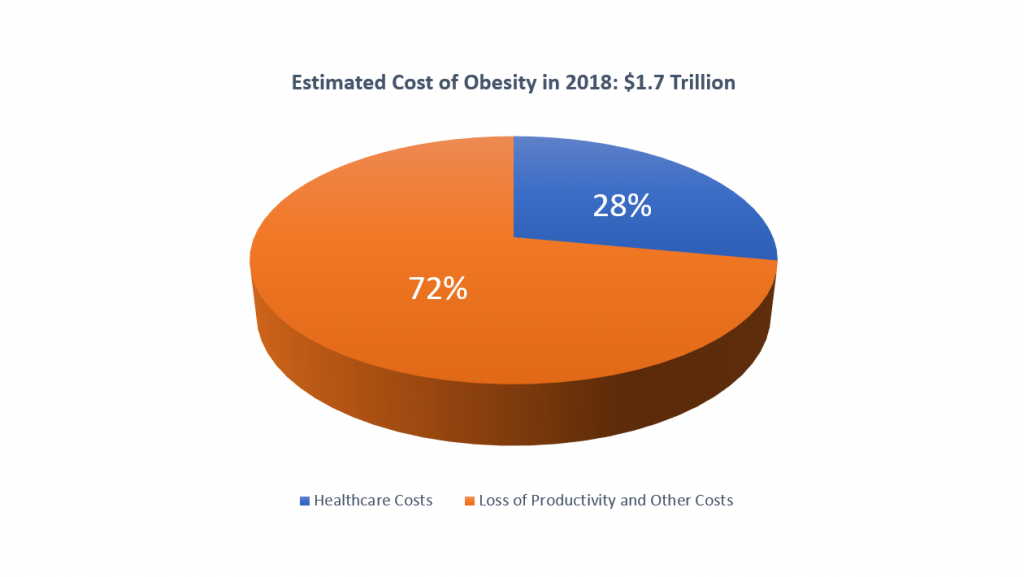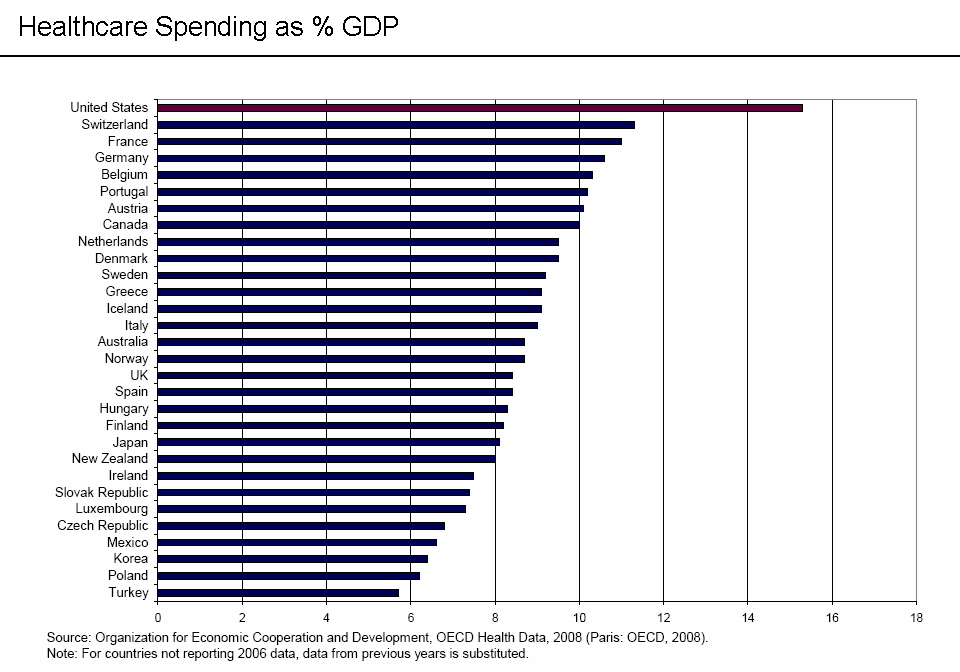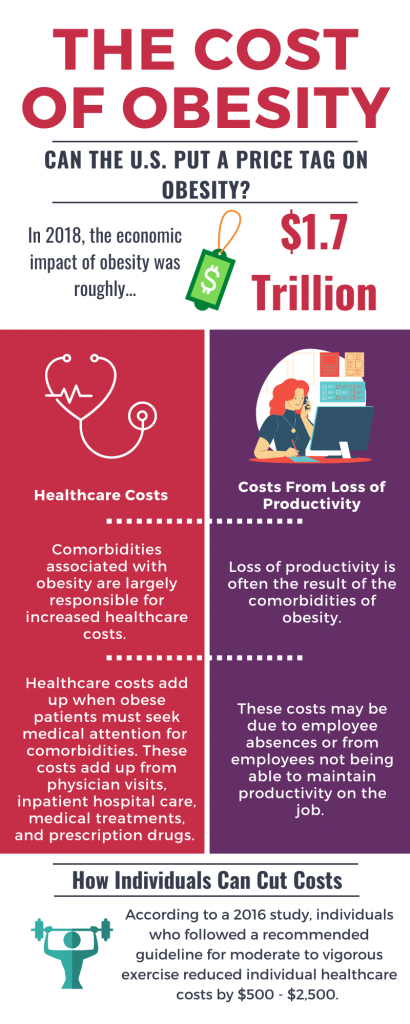19 The Cost of Obesity
Victoria Kellogg
What is the Estimated Cost of Obesity?

One way to better understand the impact of obesity is to look at the associated costs. According to an article published in 2018 that identified the economic impact of obesity, the effects of obese and overweight individuals amounted to roughly $1.7 trillion (Milken Institute, 2018). This cost is startling, but it is best to understand exactly what contributes to this number and what can be done to reduce it.
Cost of Obesity: Healthcare Needs
First, it is important to separate costs due to healthcare needs and costs due to lost productivity. Costs associated with healthcare are those that are often related to the treatment of comorbidities linked to obesity (Musich et al., 2016). This means that obesity itself doesn’t cause the rise in healthcare costs, but that the diseases that are the result of being overweight or obese do. Comorbidities linked to obesity include type 2 diabetes, cardiovascular disease, high blood pressure, etc. (Musich et al., 2016). To put the costs of comorbidities on healthcare into numbers, consider this: about 75% of osteoarthritis cases, 64% of type 2 diabetes cases, and 73% of kidney disease cases are linked to individuals being overweight or obese (Milken Institute, 2018). For more information about comorbidities and how they relate to obesity, visit the chapter Comorbidities of Obesity.
It is easy to think all these costs are from individuals visiting their healthcare providers, but the truth is that healthcare costs come from many sources. Costs add up over time through physician visits, inpatient hospital care, medical treatments, and prescription drugs (Cornell University, 2018). According to an estimate in 2018 by Milken Institute, the cost of obesity was $480.7 billion for healthcare costs alone.
Cost of Obesity: Loss of Productivity
In addition to healthcare costs are costs due to lost productivity. Some losses in productivity are due to employees being unable to work efficiently because of their health conditions, namely obesity and its related diseases (Milken Institute, 2018). For example, an overweight or obese employee may miss work to go to an appointment because of his or her cardiovascular disease and its complications. The lost productivity would be from the employee not coming to work. Another example is if an employee who is overweight or obese comes to work but is unable to perform all of his or her tasks. This person may be experiencing osteoarthritis related to obesity and may find it painful to complete certain movements. For more information about obesity in the workplace, visit the chapter Employee Health and Worksite Wellness Programs. Both examples described represent ways in which obesity causes increased costs due to loss of productivity. Healthcare costs and costs from lost productivity add together to create over a trillion dollars’ worth of costs, but why is everything so expensive?
The Cost of Healthcare in the United States
When thinking about the costs related to obesity, it is important to consider how the United States compares to other countries. The United States pays nearly double the average physician salary, spends almost twice as much per person on pharmaceuticals, and spends over two times the average amount of total health expenditures on administration (Papanicolas, 2018). While obesity and its comorbidities do increase costs in healthcare, the healthcare system itself is very expensive (Papanicolas, 2018). Healthcare in the United States is very costly, so living with chronic conditions related to obesity is costly as well.

How Individuals Can Lower Costs
Even though healthcare is naturally expensive in the United States, individuals can still be proactive in lowering their own costs. In a study done in 2016, participants followed a recommended guideline of moderate to vigorous exercise to see how their healthcare costs would be affected. Moderate exercise typically results in a light sweat and an increase in breathing and heart rate. An example of moderate exercise is fast walking. Vigorous exercise has a much greater physical result, and examples include running, swimming laps, and other aerobic activities (American Heart Association, 2016). For the participants who were at risk for cardiovascular disease, exercise alone reduced their medical costs by roughly $2500 a year. A similar decrease in healthcare costs of $500 was even seen for healthy individuals who participated in the study and followed regular exercise routines (American Heart Association, 2016). No matter the health condition of an individual, following an exercise routine can greatly improve many aspects of life – especially by reducing healthcare costs and increasing productivity.
Summary
In summary, the impact of obesity weighs heavily on the costs of healthcare and the costs associated with lost productivity (as shown in the infographic below). High healthcare costs are a result of comorbidities related to obesity and an expensive healthcare system (Musich et al., 2016). Decreased productivity from work absences and the inability to perform work tasks can also result in higher costs (Milken Institute, 2018). Many factors impact obesity and its costs, but one tool individuals can use to improve their health and reduce individual costs is regular exercise. Costs from obesity may be staggering, but all individuals have the power to reduce them.

Review Questions
1. According to this chapter, how can the costs related to obesity be divided?
A) Costs associated with healthcare and costs associated with dieting
B) Costs associated with prevention and costs associated with healthcare
C) Costs associated with loss of productivity and costs associated with healthcare needs
2. Which of the following is an example from the chapter of why healthcare in the United States is more expensive than in other countries?
A) The United States spends more on prevention than any other country
B) The United States spends more money on pharmaceuticals, administration, and physician salaries
C) The United States healthcare system is larger and therefore requires more funding
3. What is one recommendation mentioned in the chapter for lowering healthcare costs related to obesity?
A) Encourage both obese and healthy individuals to exercise
B) Increase the number of doctors specializing in obesity
C) Regulate the marketing of unhealthy foods
References
American Heart Association. (2016, September 7). Exercise can help keep medical costs down. Heart.org. https://newsroom.heart.org/news/exercise-can-help-keep-medical-costs-down
Cornell University. (2018, February 8). Obesity drives U.S. health care costs up by 29 percent, varies by state. ScienceDaily. www.sciencedaily.com/releases/2018/02/180208180356.htm
Milken Institute. (2018, October 30). Economic impact of excess weight now exceeds $1.7 trillion. Science Daily. https://www.sciencedaily.com/releases/2018/10/181030163458.htm
Musich, S., MacLeod, S., Bhattarai, G. R., Wang, S. S., Hawkins, K., Bottone, F. G., Jr, & Yeh, C. S. (2016). The impact of obesity on health care utilization and expenditures in a Medicare supplement population. Gerontology & geriatric medicine, 2, 2333721415622004. https://doi.org/10.1177/2333721415622004
Papanicolas, I. (2018, March 13). Health care spending in US and other high-income countries. The Commonwealth Fund. https://www.commonwealthfund.org/publications/journal-article/2018/mar/health-care-spending-united-states-and-other-high-income
existing simultaneously with and usually independently of another medical condition.
a common form of diabetes mellitus that develops especially in adults and most often in obese individuals and that is characterized by hyperglycemia resulting from impaired insulin utilization coupled with the body's inability to compensate with increased insulin production
of, relating to, or involving the heart and blood vessels
a common form of arthritis typically with onset during middle or old age that is characterized by progressive degenerative changes in the cartilage of one or more joints (as of the knees, hips, and hands) accompanied by thickening and overgrowth of adjacent bone and that is marked symptomatically chiefly by stiffness, swelling, pain, deformation of joints, and loss of range of motion —abbreviation OA
continuing or occurring again and again for a long time

